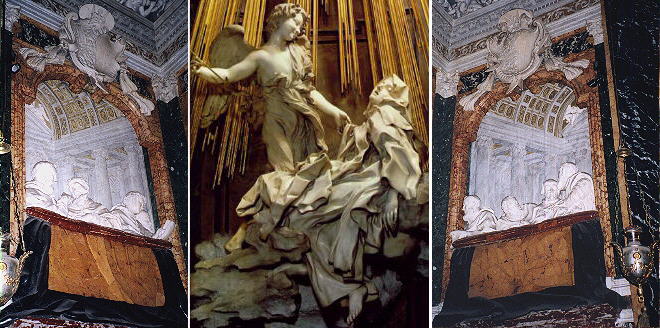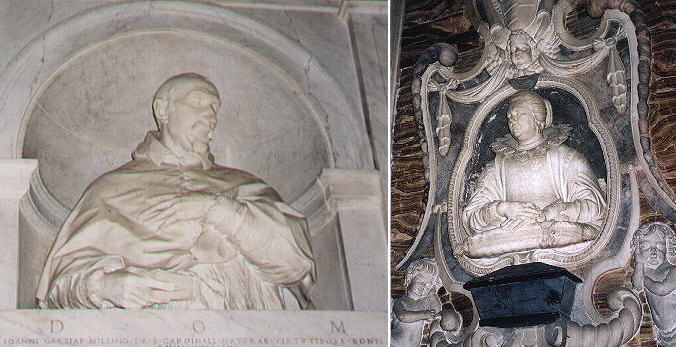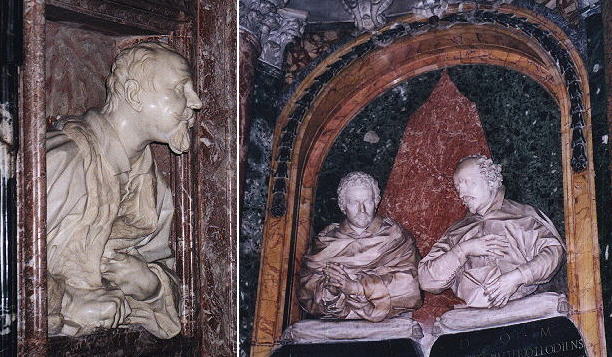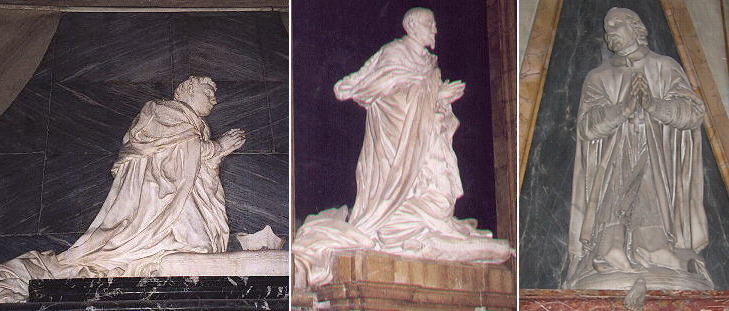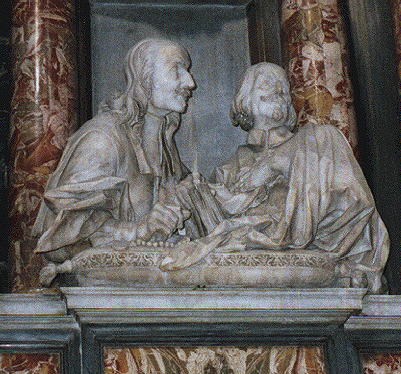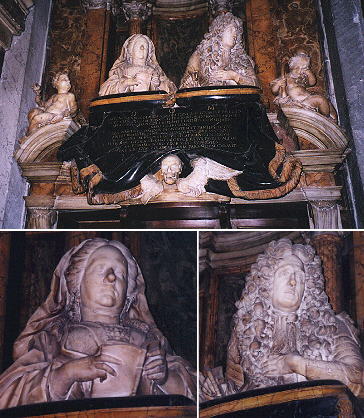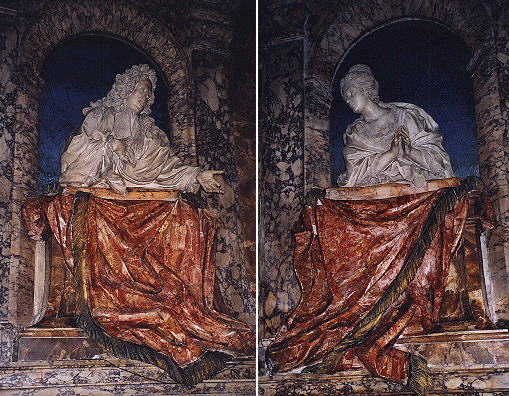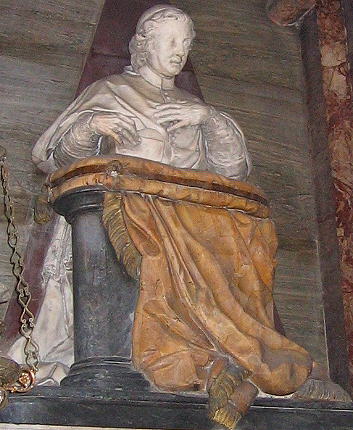  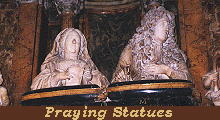 Praying Statues Praying Statues
This page deals with baroque sculptures following the same pattern: they are funeral
monuments, usually on the side walls of chapels and they show the dead in the act of praying behind a kneeling-stool.
Busts in the act of praying became quite common in the XVIIth century in many European countries. The change towards showing not much more than the bust of the dead, but behind a kneeling-stool (or just behind the top of it), was introduced by Alessando Algardi in his Monument to Cardinal Garcia Millini in S. Maria del Popolo.
Algardi did not sculpt the kneeling-stool, but in seeing the statue we get the impression that it is a full body statue of which we see only the upper part. The cardinal is shown with his prayer book and in the act of beating (gently) his breast. The idea suggested by this monument was immediately developed in a clearer way, usually by sculpting a cushion before the bust: you can see this in a monument by Giuliano Finelli in S. Caterina da Siena a Magnanapoli. Finelli who started his career with Gian Lorenzo Bernini, ended it by adhering to the recommendations of the Accademia di S. Luca for "classical" art. Gian Lorenzo Bernini made use of this kind of sculptures in designing Cappella Raimondi in S. Pietro in Montorio and Cappella Cornaro in S. Maria della Vittoria.
Bernini sculpted personally the Monument to Gabriele Fonseca, a wealthy Portuguese doctor, in S. Lorenzo in Lucina. It is a portrait full of life, typical of Bernini's sculpture. In the church of S. Maria dell'Anima we can compare a work by Alessandro Algardi, the leader of the classical school, with a work by Ercole Ferrata, one of Bernini's best scholars. The intense devotion of the young man, represented in a very classical way, (left/Algardi) makes somewhat melodramatic the attitude of the cardinal (right/Ferrata). In some monuments in large chapels or in the naves of the church we see a full body sculpture or to be more precise a full body high relief. The monument to Cardinal Pimentel in S. Maria sopra Minerva was designed by Gian Lorenzo Bernini and executed by his scholars. This position of the dead will show up again in Bernini's Monument to Alexander VII.
As in many other cases the themes and ideas suggested by Bernini were used by other architects and sculptors. Carlo Fontana designed the Ginetti Chapel in S. Andrea della Valle and he asked Antonio Raggi, a scholar of Bernini, to portray Cardinal Ginetti in a position very similar to that of Cardinal Pimentel. Domenico Guidi is one of the few sculptors of the XVIIth century who did not work for Bernini. He was the preferred pupil of Alessandro Algardi and at his death he inherited his "customers". For many years he had a very busy workshop as he offered his services at a very competitive price. A monument by him can be seen in S. Maria in Aquiro. In the church of Gesł e Maria the funeral monuments of the family Bolognetti are in the nave. Giorgio Bolognetti, bishop of Rieti, had contributed to such an extent to the cost of the decoration of the church that he was allowed to erect the funeral monuments for his family in the nave: for this reason the church was also called il Cappellone (the large chapel).
The church was a sort of family chapel of Marquis Santacroce, who lived nearby. As we can see he dressed in the French way and wore a wig. While the marchioness is portrayed in a very stiff attitude, the marquis beats his breast like the cardinals of Algardi and Ferrata. The XVIIIth century was a very disenchanted time, even in Rome. Acts of contrition were no longer popular and the rich were more interested in minuets. This showed up also in funeral monuments.
Giovanni Andrea Muti and his wife had a palace near SS. Venanzio e Ansovino, but they preferred to buy a chapel in the more fashionable church of S. Marcello al Corso. The monuments designed for the Muti by Bernardini Cametti are formally very similar to those built in the XVIIth century, but the spirit is different. The viewer has the impression that the husband is inviting his coy wife to dance. In general the Baroque period in Rome is considered closed by 1750, so Paolo Posi who worked in Rome mainly after 1750 is not mentioned in many books and essays about Baroque Rome: he designed however some funeral monuments which for the use of color and different materials belong to the baroque tradition: in particular his monument to Maria Flaminia Odescalchi Chigi in 1771 can be regarded as the last baroque tomb in Rome.
Other pages dealing with Baroque sculpture: Monuments showing the dead in a medallion Representation of Death in Baroque sculptures Baroque Angels Three chapels by Gian Lorenzo Bernini Three busts by Alessandro Algardi Baroque Monuments to the Popes Baroque High Reliefs Statues Close to Heaven Embittered Andrew (the statues in St. Peter's octagon) Laughing Masks Playing with Colours See also my List of Baroque Architects and my Directory of Baroque Sculpture.
Go to my Home
Page on Baroque Rome or to my Home Page on Rome
in the footsteps of an XVIIIth century traveller.
|
All images © 1999 - 2003 by Roberto Piperno. Write to romapip@quipo.it
